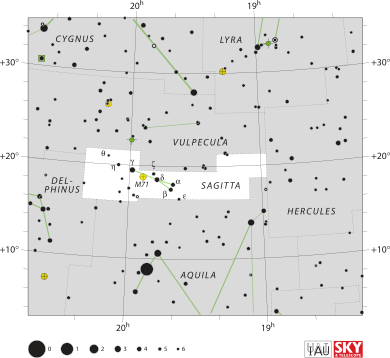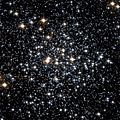Sagitta facts for kids
| Constellation | |

List of stars in Sagitta
|
|
| Abbreviation | Sge |
|---|---|
| Genitive | Sagittae |
| Pronunciation | Sagítta, genitive |
| Symbolism | the Arrow |
| Right ascension | 19.8333 |
| Declination | +18.66 |
| Quadrant | NQ4 |
| Area | 80 sq. deg. (86th) |
| Main stars | 4 |
| Bayer/Flamsteed stars |
19 |
| Stars with planets | 2 |
| Stars brighter than 3.00m | 0 |
| Stars within 10.00 pc (32.62 ly) | 1 |
| Brightest star | γ Sge (3.51m) |
| Messier objects | 1 |
| Bordering constellations |
Vulpecula Hercules Aquila Delphinus |
| Visible at latitudes between +90° and −70°. Best visible at 21:00 (9 p.m.) during the month of August. |
|
Sagitta is a small but special group of stars in the northern sky. It looks like a tiny arrow! Its name comes from Latin, meaning "arrow." Don't mix it up with Sagittarius, which is a much bigger constellation that looks like an archer.
Even though Sagitta is very old, none of its stars are super bright. It's also the third smallest constellation in the sky. Only Equuleus and Crux are smaller. An ancient astronomer named Ptolemy first wrote about Sagitta almost 2,000 years ago. Today, it's still one of the 88 official constellations. You can see Sagitta from almost anywhere on Earth, except for the very bottom of the world near the South Pole.
Contents
Sagitta: The Little Arrow Constellation
Sagitta is a cool constellation that looks like an arrow flying through space. It's easy to spot if you know where to look, even though its stars aren't super bright. It's a fun challenge for young stargazers!
What Makes Sagitta Special?
Sagitta is one of the oldest constellations we know about. People have been looking at it for thousands of years! It's part of a group of constellations called the Hercules family. This means it's near other constellations like Hercules and Aquila.
How Big is Sagitta?
Sagitta is tiny! It's the 86th largest constellation out of 88. This makes it one of the smallest groups of stars in the night sky. But even though it's small, its arrow shape makes it easy to recognize.
Stars in Sagitta
The brightest star in Sagitta is called Gamma Sagittae. It's a type of star known as a red giant. Red giants are very large stars that are nearing the end of their lives. Gamma Sagittae shines with a brightness that astronomers call an "apparent magnitude" of 3.47. The lower the number, the brighter the star appears from Earth.
Planets Around Sagitta's Stars
Scientists have found planets orbiting two of the star systems in Sagitta. This means there are other worlds out there, circling stars that are part of our little arrow constellation! It's exciting to think about what those planets might be like.
Where to Find Sagitta
Sagitta is located in the northern part of the sky. It's usually visible during the month of August. You can find it near other constellations like Vulpecula, Hercules, Aquila, and Delphinus. Look for its distinct arrow shape!
Images for kids
-
Sagitta can be seen above Aquila in this plate from Urania's Mirror (1825).
See also
 In Spanish: Sagitta para niños
In Spanish: Sagitta para niños



